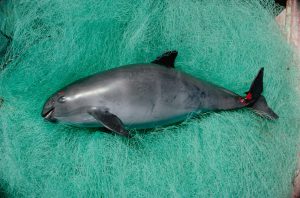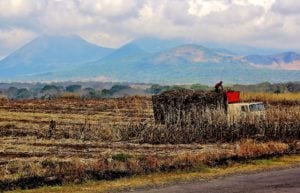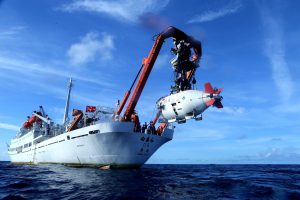The ocean is home to millions of species, many of which are still unknown to humans. It supplies us with oxygen and each year absorbs nearly 25% of the greenhouse gases we produce by burning fossil fuels. However, vast areas of the high seas, which cover nearly half of the Earth’s surface, remain unregulated.
Countries are currently negotiating a landmark global deal known as the BBNJ (Biodiversity Beyond National Jurisdiction), which for the first time would plug this significant gap while tackling the increasing pressures of activities such as fishing and mining, and marine pollution.
But the 48-page draft text for negotiation released by the United Nations in June indicates the wide-ranging differences that remain between nations.
“The negotiation is entering [its] technical phase, yet obviously the draft is still heavily bracketed [open for debate], and many of the differences [that] remain [are] political, not likely to be resolved at [the] technical level,” said Chen Jiliang, researcher at Greenovation Hub, a non-governmental organisation in Beijing.
Ahead of negotiations in New York later this month, some observers are worried about whether a legally binding deal can be reached in 2020 as scheduled. There is only one more round of talks planned next year.
‘Paris of the high seas’
Hailed by some conservationists as the “Paris Agreement for the high seas”, the challenges for diplomats, conservationists and scientists are equally, if not more, grave than the landmark climate deal reached in France in 2015. The high seas treaty must not only protect marine biodiversity, but accommodate existing legal treaties, and bridge a deep north–south divide in the development statuses, technological capacities and conservation beliefs of the countries involved.
Along with other contentious issues, such as creating marine protected areas and adopting environmental impact assessments for activities like mining, a core element of the debates is how countries will access and share the benefit derived from the ocean’s marine genetic resources in a fair and equitable manner.
New biological findings and technological developments have made marine organisms the object of commercial interest. From the biggest whale to the tiniest microbe, corporations and researchers are looking for genetic sequences that have immense potential value for the pharmaceutical, biofuel and chemical industries. Some of these sequences are associated with patents, allowing corporations and research institutions the sole right to conduct research on them and produce products related to them. An example is the US chemical company Dow successfully isolating the genes that produce Omega 3 – a beneficial fatty acid mostly derived from fish – and splicing it into canola, a crop widely grown to produce cooking oil.
The global market for marine biotechnology is projected to reach USD 6.4 billion by 2026. There are currently 12,998 patents involving 862 marine species. German-based chemical giant BASF has so far registered 47% of all marine sequences included in gene patents.
Top 10 countries claiming patents involving marine genetic sequences
| by 2009 | by 2017 | ||
| Germany | 199 | US | 6,278 |
| US | 149 | Germany | 1,450 |
| Japan | 128 | Japan | 1,431 |
| Israel | 34 | France | 848 |
| UK | 33 | UK | 669 |
| Norway | 24 | Denmark | 632 |
| France | 17 | Belgium | 366 |
| Denmark | 13 | Netherlands | 105 |
| Canada | 11 | Switzerland | 103 |
| Netherlands | 9 | Norway | 66 |
| … | … | ||
| China | 1 | China | 1 |
Source: Marine Biodiversity and Gene Patents and Corporate control and global governance of marine genetic resources
Yet there are two conflicting principles – both endorsed in the 1982 United Nations Convention on the Law of the Sea (UNCLOS) – which govern their exploration and exploitation. These have been hotly contested since the very beginning.
‘Freedom of high seas’ versus ‘common heritage’
The freedom of high seas principle gives countries the right to navigate, fly over, fish and carry out scientific research on the ocean that lies beyond exclusive economic zones and so belongs to no country.
In 1967, it was proposed that the sea would be open to all countries, but subject to international regulation for the common good of all humanity.
UNCLOS eventually declared “the Area” – seabed and subsoil beyond national jurisdiction – as the common heritage of mankind. The International Seabed Authority (ISA) was later founded to oversee exploration and subsequent mining of deep-sea resources, aiming to ensure benefits are shared equitably.
These seemingly contradictory ideals pose daunting challenges for negotiating the new deal, which covers not only the high seas, where the freedom principle prevails for human activities, but also the Area, where the common heritage of mankind principle applies.
If the freedom principle applies, whoever acquires the genetic material in the deep sea could enjoy exclusive rights over whatever products they develop. But if the organisms are recognised as the common heritage of mankind, developing countries will also be entitled to share in the benefits.
Governance gaps
In negotiation rooms, the situation is further complicated by yawning gaps between the economic and technological strength of countries in the global north and south.
In the draft text, almost all of Part II, which is dedicated to marine genetic resources, remains bracketed. Countries disagree on everything from what counts as genetic resources, where and how they are accessed and collected, to the objectives of the treaty and how countries will share the benefits.
Hu Xuedong, deputy head of the China Ocean Mineral Resources Research and Development Association, said countries are largely grouped into three.
There are the industrialised countries with sophisticated technology to exploit the resources who would like as little restriction as possible (the United States, Japan and Russia). On the other side are the developing countries who are demanding a fair and equitable share of benefits. Somewhere in the middle is the European Union, which has a strong foothold in marine technology but is hoping to prioritise conservation. Hu points out that the EU adopts a rather pragmatic view to push forward the negotiations. And according to Hu, there are already signs that the “resource exploiting” group and the “pragmatically moving forward” group are gaining an upper hand in preparatory discussions.
China: between north and south
In the latest talks, China joined the G77 group of developing countries in demanding that “the principle of common heritage of mankind must underpin the new regime”, adding that the principle “should be at the core of the new instrument”.
Professor Xue Guifang, of the Centre for Polar and Deep Ocean Development at Shanghai Jiaotong University, explained that this common heritage principle was “a hard-fought victory” for developing countries in negotiating seabed mining. “As a result, this is a position that China, as a developing country, is unlikely to give up.”
But as China is making rapid progress in deep-sea bioprospecting technologies, the country seems to be more willing to stay in the middle of the north–south divide, according to both Xue and Chen.
In a 2017 press conference, the State Oceanic Administration announced it had been rapidly expanding its collections of deep-sea microbes since 2002 and had completed the DNA sequencing of 300 so far.
Genetic sequences associated with patents, by 2017
| Type | Species | Sequences |
| Microbes | 634 | 9,468 |
| Fish | 88 | 2,055 |
| Crustaceans | 26 | 187 |
| Corals | 25 | 185 |
| Molluscs | 24 | 334 |
| Anemones | 16 | 89 |
| Jellyfish | 10 | 162 |
| Plants | 9 | 175 |
| Worms | 9 | 54 |
| Sea urchins | 7 | 103 |
| Sea squirts | 6 | 135 |
| Lancelets | 4 | 18 |
| Sea pineapples | 1 | 2 |
| Sponges | 1 | 26 |
| Starfish | 1 | 1 |
| Whales | 1 | 4 |
Source: Corporate control and global governance of marine genetic resources
In an interview with National Oceanic News, the official newspaper of the administration, Shao Zongze, director of State Key Laboratory of Marine Biogenetic Resource, emphasised a sense of urgency to collect, research and patent the microbes, and eventually commercialise the findings.
As such, China seems to be keen to create some space for itself to manoeuvre. In its official submission to the UN, China stated the new international instrument should advance the “common wellbeing of humankind”, a slight language tweak that might suggest a deviation from the common heritage principle.
“The vagueness could be a deliberate move,” said Xue.
China seems to prefer unrestricted access to the living resources in the deep sea, which would be supported by a freedom of high seas principle. Yet on exploiting the resources, it prefers the benefit-sharing common heritage of mankind principle, according to Xue.
Every country will need to make some concessions towards a final deal, though time is running out.
“It seems not every country is in a hurry to hammer out a final deal,” said Chen, “but if there is limited progress at the upcoming talks in New York, we will need a higher level of political will before we can reach a substantial deal next year.”
This article was first published on chinadialogue ocean
![<p>Star fish in deep sea [Image by: NOAA]</p>](https://dialogue.earth/content/uploads/2019/08/star-fish-in-deep-sea-1327x720-1.jpg)







